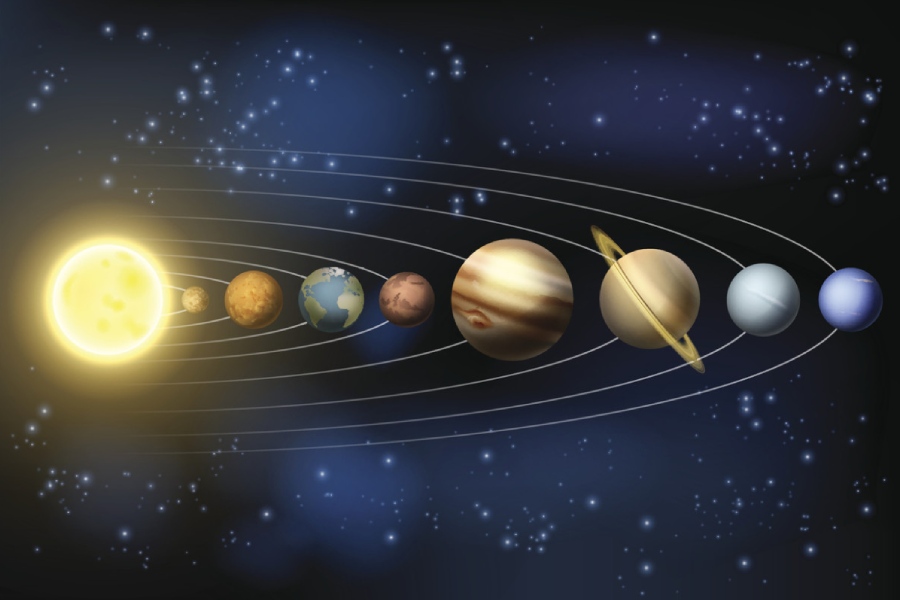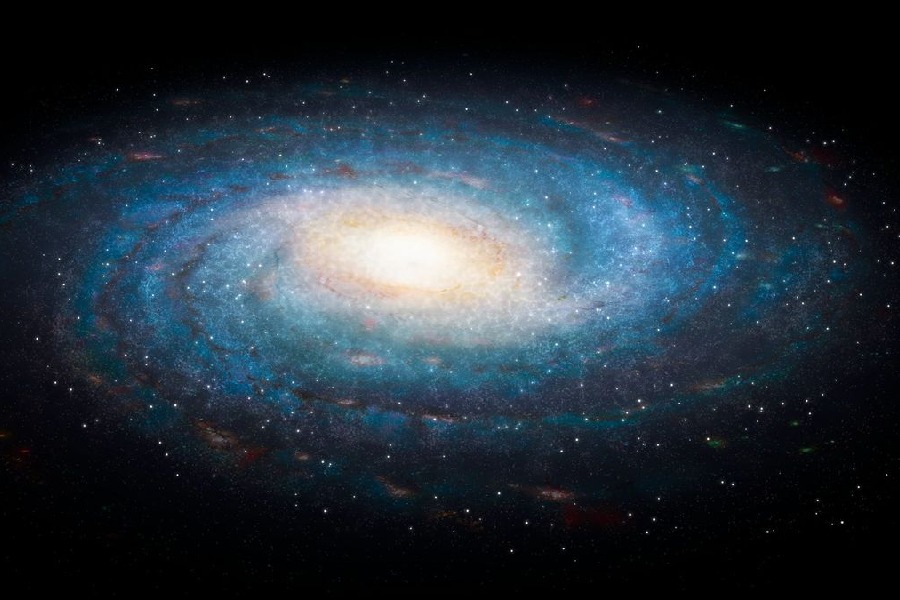For centuries, humanity has gazed at the night sky, marveling at the graceful dances of celestial bodies. While the motion of stars may seem erratic, the planets trace out a predictable path, seemingly following invisible tracks across the celestial backdrop.
But contrary to popular belief, these tracks are not perfect circles. Instead, planets, moons, and countless other objects in our solar system and beyond travel in elliptical orbits. This deviation from the idealized circular path raises a fundamental question – why do planets travel in elliptical orbits?
This question takes us on a captivating journey through the realm of celestial mechanics, where the laws of physics paint a beautiful picture of the forces at play. We’ll begin by exploring the foundational laws laid down by Johannes Kepler, followed by the gravitational dance orchestrated by Newton’s law of universal gravitation.
We’ll examine the stability and conservation laws that govern celestial motion before unraveling the formation and evolution of these elliptical paths. Finally, we’ll examine how planetary interactions and resonances can further shape and modify these orbits, creating the dynamic tapestry of our solar system.

Why Do Planets Travel in Elliptical Orbits?
So, why do planets travel in elliptical orbits? Planets follow elliptical orbits due to the gravitational interplay between a planet and its star acting as a centripetal force, maintaining the orbit’s shape.
The elliptical orbit stems from the balance between gravitational pull and the planet’s initial velocity, creating a dynamic equilibrium in accordance with Kepler’s laws. Kepler’s laws offer a mathematical depiction of planets’ elliptical orbits.
The Law of Ellipses, Kepler’s first law, describes the planetary orbit as an ellipse with the Sun at one focus. This observational-based framework provides key insights into the governing principles of celestial motion in our solar system.
Kepler’s laws of planetary motion – Elliptical revelations
In the early 17th century, Johannes Kepler meticulously analyzed the astronomical data available at the time, particularly the observations of Tycho Brahe. Kepler’s dedication resulted in his three laws of planetary motion, revolutionizing our understanding of the cosmos.
His first law, known as the law of ellipses, shattered the misconception of circular orbits. Kepler revealed that planets trace out elliptical paths around the Sun, with the Sun occupying one of the two foci of the ellipse.
This seemingly minor detail held immense significance, as it laid the groundwork for understanding the true nature of planetary motion.
Gravitational dynamics – The dance of forces
While Kepler provided the geometric description of planetary motion, Isaac Newton’s law of universal gravitation unveiled the underlying physical principles.
This law states that any two objects with mass attract each other with a force proportional to the product of their masses and inversely proportional to the square of the distance between them. In simpler terms, gravity acts like an invisible tug-of-war, pulling objects towards each other.
This gravitational pull is what governs the motion of planets in the Solar System. The Sun, with its immense mass, exerts a dominant gravitational pull on all planets. As planets respond to this pull, they don’t simply fall directly towards the Sun. Instead, their inertia, the tendency of an object to resist a change in motion, creates a balance.
The planet moves forward while simultaneously being pulled towards the Sun, resulting in the characteristic elliptical orbit.
Stability and conservation laws – The balancing act
Maintaining orbit stability
Why are some elliptical orbits more stable than others? This stability is governed by the interplay of two fundamental principles – conservation of energy and conservation of angular momentum.
Conservation of energy states that the total energy of a closed system remains constant. In the case of a planet orbiting the Sun, its energy consists of kinetic energy due to its motion and potential energy due to its position in the gravitational field.
As the planet moves closer to the Sun, its potential energy decreases while its kinetic energy increases to maintain the total energy constant. This explains why planets move faster at perihelion, the point closest to the Sun, and slower at aphelion, the point farthest away.
Balancing centrifugal and centripetal forces
Conservation of angular momentum states that the total angular momentum of a closed system remains constant. In simpler terms, the spinning motion of an object, combined with its distance from the axis of rotation, remains constant.
As a planet gets closer to the Sun, its orbital speed increases, but to maintain its angular momentum, its distance must decrease. This results in a flattened ellipse.
These conservation laws dictate the shape and stability of planetary orbits. A perfectly circular orbit represents a specific balance between gravitational pull and inertia, while elliptical orbits reflect deviations from this ideal state.
Alignment of orbital direction
Do planets orbit in the same direction? Yes, all planets circle anti-clockwise around the Sun from Earth’s north pole perspective.
This shared direction results from angular momentum conservation. The initial spinning nebula that condensed into planets revolved in one orientation. Residual momentum maintained near-identical orbital inclinations.

Formation and Evolution of Elliptical Orbits – A Cosmic Genesis
Understanding elliptical orbits requires delving into the very formation of planetary systems. Planets are born from swirling disks of gas and dust called protoplanetary disks. As clumps within the disk collapse due to gravity, they eventually coalesce into planets.
The initial distribution of mass and angular momentum within the disk, along with gravitational interactions between forming planets, determines the final orbital parameters. For example, if a planet forms further from the star, it inherits less angular momentum, leading to a more elongated elliptical orbit.
Conversely, planets forming closer to the star have a higher angular momentum, resulting in orbits closer to circular. Additionally, gravitational encounters between planets during their formation can alter their orbits, further shaping their elliptical nature.
Which planet has the most elliptical orbit?
Of the eight planets in our Solar System, Mercury has the most elliptical orbit around the Sun. Its orbit has an eccentricity of 0.21, meaning it deviates quite substantially from a circular path. This causes Mercury’s distance from the Sun to vary between ~28 million miles at perihelion and ~43 million miles at aphelion.
The reason Mercury experiences such high eccentricity stems from it being the closest planet to the Sun. It orbits deep within the Sun’s enormous gravitational force, which has acted to stretch and elongate its orbital path over billions of years of planetary perturbations.
The resulting marked elliptical route brings Mercury much nearer on one close passage versus its most distant swing around our star. No other planet ventures so close to the stellar furnace.
Do planets orbit in a plane?
Yes, it has been observed that planets orbit in a plane around stars like our Sun. But why do planets orbit in a plane?
This happens because solar systems form from a large cloud of spinning gas and dust. As this cloud collapses, the conservation of angular momentum causes it to flatten into a rotating disk with most material orbiting in the same plane.
Within this disk, particles collide and accumulate over time to form asteroid-sized planetesimals and eventual full-sized planets, which maintain orbits in the original plane.
They orbit on slightly inclined planes, like spinning coins around the central bulge of mass. This explains the near-2D alignment of planetary movements rather than scattered 3D routes.
Planetary Migration and Resonances – A Dynamic Dance
The story of elliptical orbits doesn’t end with their formation. Planets are not static entities, and their orbits can change over time due to various factors.
One such factor is planetary migration. Here, the gravitational influence of other planets, particularly gas giants, can nudge a planet into a new orbit.
This migration can be caused by gravitational slingshots, where a planet passes close to another and exchanges momentum or through resonant interactions.
How resonances and collisions reshape orbits
Resonances occur when the orbital periods of two planets are in a simple ratio, creating a repeating gravitational tug-of-war. This can lead to significant changes in their orbits, including eccentricity.
For example, Pluto and Neptune are in a 3:2 resonance, meaning Pluto orbits the Sun three times for every two orbits of Neptune. This resonance keeps Pluto’s orbit highly elliptical, preventing it from colliding with Neptune.
Besides resonances, other factors like collisions with asteroids or comets can also alter a planet’s orbit, potentially changing its eccentricity. These dynamic interactions paint a picture of a constantly evolving solar system, where the seemingly stable elliptical paths are constantly subject to subtle and sometimes dramatic shifts.
Beyond Our Solar System – A Universe of Diverse Orbits
The fascination with elliptical orbits extends beyond our own solar system. Our current understanding of planetary formation suggests that most exoplanets also likely travel in elliptical paths.
This is supported by observations using techniques like the transit method, which detects exoplanets as they pass in front of their host stars. By analyzing the transit duration and light variations, astronomers can infer the size and orbital parameters of exoplanets.
This reveals a diverse array of elliptical orbits among the exoplanets. The transit and light variation data enables astronomers to uncover these elliptical orbits and other orbital properties.
Furthermore, studying the orbits of stars in binary systems, where two stars orbit each other, provides another avenue for understanding elliptical motion. These systems often exhibit highly eccentric orbits due to their strong gravitational interactions, offering valuable insights into the dynamics of celestial bodies.
Conclusion
The question of why planets travel in elliptical orbits takes us on a captivating journey through celestial mechanics. We begin with Kepler’s laws, the foundation of our understanding, and dive into the gravitational forces orchestrated by Newton’s law.
We hope this exploration of why do planets travel in elliptical orbits has evolved your understanding of what physics governs the shape of planetary orbits.
We analyzed the balancing act of conservation laws and witnessed the dynamic interplay of formation, migration, and resonances in shaping these orbits. Ultimately, the answer lies in the intricate dance of gravity, inertia, and the initial conditions that gave birth to our Solar System and countless others.
Studying elliptical orbits not only reveals the intricate workings of our celestial neighborhood, but also provides a window into the rich diversity of planetary systems throughout the universe.
As we continue to explore the cosmos, the mysteries of elliptical orbits will continue to inspire our quest to understand the majestic choreography of the cosmos.
